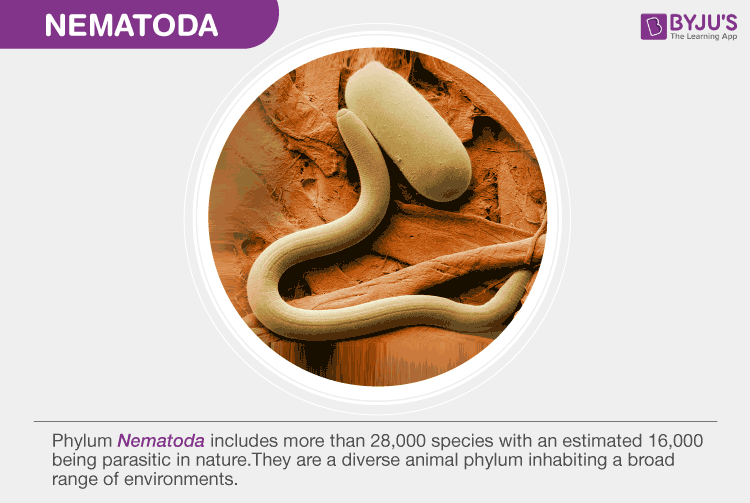The organisms belonging to the phylum Nematoda are also known as “roundworms”. There are 28000 species of Nematoda identified till date. They are unsegmented vermiform animals. The epidermis has dorsal and ventral nerve cords.

The Nematodes present in the soil feed on the bacteria, fungi, and other nematodes, and play an important role in nutrient recycling. They also attack the insects and control the pests. However, they cause severe damage to plants. They feed on the plant roots and reduce the nutrient uptake and stress tolerance of the plant.
A spadeful of soil contains numerous Nematodes. They cause diseases such as Ascariasis, Trichuriasis, Hookworm, Enterobiasis, Filariasis, and Angiostrongyliasis in humans.
They are characterized and categorized in the following ways.
Characteristics of Nematoda
Following are the important characteristics of Nematoda:
-
Their body is bilaterally symmetrical and triploblastic.
-
They are cylindrical in shape.
-
They exhibit tissue level organization.
-
Their body has a cavity or pseudocoelom.
-
The alimentary canal is distinct, with the mouth and the anus.
-
They are sexually dimorphic.
-
They are devoid of the circulatory system and respiratory system.
-
They are free-living or parasitic.
-
Parasitic nematodes cause diseases in the host.
-
Fertilization is internal and reproduction is sexual.
-
Their cuticle moults periodically.
-
The epidermis is synctical and contains dorsal or ventral nerve cords.
-
The body-wall muscles are longitudinal.
-
They possess amoeboid sperm cells.
-
They consist of chemosensory organs called aphids situated on the lips.
Also read: Diseases caused by Nematodes in Humans
Classification of Nematodes
Nematodes are classified into the following classes:
Phasmidia or Secernentea
-
These are mostly parasitic.
-
Caudal glands are absent.
-
Unicellular, pouch-like sense organs called plasmids are present.
-
The excretory system has paired lateral canals.
-
Eg., Ascaris, Enterobius
The class Phasmidia is divided into the following orders:
Rhabditida
-
They have smooth and ringed cuticle.
-
There is a posterior lobe at the pharynx.
-
They are free-living and parasitic.
-
Males have copulatory spicules.
-
Eg., Rhabditis
Strongylida
-
They are vertebrate parasites devoid of lips.
-
The pharynx has no bulb.
-
They have a well-developed buccal capsule.
-
They possess a true copulatory bursa.
-
For eg., Strongylus
Oxyurida
-
They can be small or moderate in size.
-
Males have copulatory spicules.
-
Caudal alae are present.
-
They can be invertebrates or vertebrates.
-
The mouth consists of 3-4 simple lips.
-
For eg., Oxyuris
Ascaridida
-
These are oviparous, large stout nematodes living as parasites in the intestine of the vertebrates.
-
The pharynx may or may not contain a posterior bulb.
-
Mouth possess 3 prominent lips.
-
There is no buccal capsule.
-
For eg., Ascaris
Spirurida
-
These are thread-like organisms that vary in size from moderate to large.
-
The pharynx is devoid of bulb.
-
The females are larger than males and can be oviparous or viviparous.
-
The mouth contains two prominent lips.
-
For eg., Spirura
Trichuroida
-
These are commonly known as whip-worms.
-
They possess a slender pharynx.
-
The mouth is devoid of lips.
-
For eg., Trichuris
Camallanida
-
These are oviparous, thread-like organisms.
-
The males have no bursa.
-
The bursa of adult females is degenerated.
-
For eg., Camallanus
Aphasmidia or Adenophorea
-
They are free-living organisms.
-
The excretory system has no lateral canals.
-
Caudal glands are present.
-
Phasmids are absent.
-
Eg., Capillaria, Trichinella
The class Aphasmidia or adenophorea is divided into the following orders:
Enoplida
-
They are mostly marine.
-
The cuticle contains bristles.
-
These are Cyanthiform amphids.
-
For eg., Anticoma
Dorylaimida
-
The cuticle is smooth without any bristles.
-
These are mostly terrestrial.
-
The buccal cavity consists of a protrusible spear.
-
It consists of 6-10 labial papillae.
-
For eg., Trichodoris
Mermithida
-
The cuticle is smooth.
-
Amphids are reduced.
-
In the larval stage, they live as parasites, whereas, the adult stage is free-living.
-
For eg., Mermis, Agamermis
Chromedorida
-
The cuticle is smooth or ringed.
-
The cuticle is devoid of any bristles.
-
There is a posterior bulb at the pharynx.
-
They are free-living or marine.
-
For eg., Paracanthonchus
Desmoscolecida
-
The cuticle is ringed with prominent bristles.
-
There are four sensory bristles at the anterior end.
-
They are marine or free-living.
-
For eg., Desmoscolex
Monohysterida
-
The cuticle is smooth, ringed and contains bristles.
-
They possess circular amphids.
-
They can be marine, freshwater, or terrestrial.
-
For eg., Monohystera
Araeolaimida
-
The cuticle is smooth and might or might not contain bristles.
-
The amphids are spiral.
-
They possess labial papillae.
-
For eg., Plectus
For more information on phylum Nematoda, characteristics of Nematoda, and the classification of Nematodes, keep visiting BYJU’S website or download BYJU’S app.
Related Links:-
| Animalia |
| Protista |

Comments